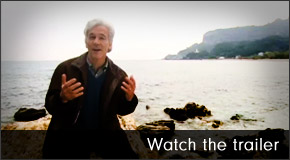Saturday
Dec312011
Small But Included in the Milky Way
By Jay McDaniel
Jesus, Jazz, and Buddhism
December 2011
http://www.jesusjazzbuddhism.org/the-milky-way.html
We're in a Larger Journey
Journey of the Universe
Many years ago, while I was driving with my son on a dark and starlit night on a country road, I turned and asked what he felt when he looked up at the stars. He paused for a moment and then said: "I feel small but included."
His phrase captures what I, too, felt that night, and what I feel as I watch the video above. The video is about the Milky Way as seen from the top of a mountain in Spain, with help from time-lapse photography. It gives you a sense of the grandeur of the Milky Way and also the beauty of life on our small planet.
After I watch the video I think of one of my own spiritual mentors, the late Thomas Berry (1914-2009). He is no longer with us in the flesh, but he lives in many a heart. My own favorite book of his is called Dream of the Earth. In that book and many others he proposes that science offers us a new story which, amid all the travails on our planet, might hold us together in gratitude. He calls it the Universe Story.
We might also call it The Journey of the Universe. I borrow this phrase from a recently produced DVD by that name, which presents the story in scientific yet poetic form. The video has been developed by two leading ecological thinkers in our time: Brian Thomas Swimme and Mary Evelyn Tucker. They are influenced by Thomas Berry, too. You can learn more about the DVD and a book they have written at www.journeyoftheuniverse.org.
Ten Thousand Journeys
Let's say that we are small but included in the Milky Way. And let's add that the Milky Way is one of perhaps a trillion galaxies, each with its incalculable multitude of stars. If this is true, then together the Milky Way and the other galaxies form a family of sorts. We live within a network of existence which Chinese call the Ten Thousand Things (萬物). Following Whitehead, we might also speak of the the Ten Thousand Journeys.
Readers of this website know that, in Process and Reality, Whitehead proposes that every event in the universe carries within it the history of the universe and adds its own momentary voice to the larger story. In his words: "The many become one and are increased by one." He adds that every entity anywhere in the universe is implicated in the journey of every other entity: "There are no self-contained facts floating in non-entity...Every actual entity is present in every other actual entity." (Process and Reality, 11, 50) In short, every journey includes every other journey.
Many Kinds of Evolution
Whitehead's metaphysics is rich and suggestive, but it is by no means enough for us to hear the story of the universe. Indeed it lacks narrative quality that can inspire the imagination; and in its generality it may lack a kind of wisdom, too, that can only be found in more particularized stories. It presents principles but not woodpeckers.
And here is where Thomas Berry is so important. Where Whitehead has a cosmology, Berry has a living story. His story includes galactic evolution, chemical evolution, biological evolution, and cultural evolution -- all of which, for him, have a spiritual component. Sometimes when we think of evolution we think primarily of the evolution of life on Earth. But Thomas Berry reminds us that galaxies and atoms evolved, too. They are still evolving and, so Whitehead adds, the laws of nature may be evolving, too. When we look up at the stars, or out at the woodpecker, or into our own bodies, we are seeing the outcome of what has evolved heretofore, but also a prospectus for a future not yet realized. Each actual entity is telling the story of the universe from its own point of view, says Thomas Berry, if only we have eyes to see. The story is unfinished. Each entity will become part of the past for a future that is not yet actual, but which will bear its influence. Ask the bark. Its future will contain the influence of the woodpecker.
A Universe filled with Qi
There's more. For Thomas Berry as for Whitehead, the history of the universe is a history of mind as well as matter, of interiority as well as exteriority, of inwardness as well as outwardness. As Whitehead puts it, each actual entity in the universe -- each piece of bark no less than each bird -- contains something like subjectivity or feeling.
The feeling at issue may not be conscious (in the case of the bark) but it has some capacity to prehend -- to feel and be influenced by -- its surroundings. On this view there is no dead matter. There are just different degrees and kinds of aliveness.
This perspective, too, is consonant with East Asian ways of thinking. Everywhere we look we see something like vital energy or qi (气). Whitehead and Berry are developing scientifically informed philosophies of qi.
On the Way Toward a New Story
Thomas Berry observes that today we humans are in between stories: the creation stories of the world’s religions and the scientific story of the evolution of the universe.
He believes that modern science is just beginning to help us find a new story but that this new story needs musicians, poets, film makers, and artists to help sing and ritualize the telling. Of course the creation stories from the world's religions are marvelous stories in their own right. But in some ways the scientists are offering new insights, new perspectives, that can evoke more understanding and awe, at least in our time. In its own way the scientific story is a religious story, too. It evokes wonder.
Not Just a Creation Story but a Creativity Story
The Ten Thousand Journeys are on a journey, the ends for which are not predetermined, not even by the initial conditions of our cosmic epoch. The emerging story is not just about origins. It is about what is happening everywhere all the time in the Milky Way and in our small planet. It is not just a creation story; it is a creativity story. Imagine for a moment that you are a spectator, dwelling somewhere outside the universe, watching the universe unfold' and that for some reason the journey stops and the universe is returned to its initial conditions. If it began anew, the universe might unfold the next time in a completely different way, because there is a creativity, a spontaneity, built into the very depths of matter. At the microscopic level we call this quantum indeterminacy. At the human level we call it freedom.
Improvising Moment by Moment
Or improvisation. Whitehead suggests that the ultimate reality of the universe is creativity and that each actual entity in the universe -- including our own lives, as lived moment by moment -- are instantiations of this creativity. We are conditioned by the entirety of the past, but our response to those conditions is not entirely determined by past influence. We might imagine the universe on the analogy of an improvisational jazz ensemble. The energy-events within the unfolding cosmos are creating themselves out of pre-existent energy-events and the scores by which they are guided, the laws of nature, are but guidelines or inherited habits by which energy has organized itself. The universe is jazz-like. Or, to put the point differently, jazz is universe-like.
Is There Life on Other Planets?
The entities in our universe may be ninety-nine percent determined by previous conditions, but they are one percent free. Where we see this creativity most pronounced, though, is in life on earth: in people, to be sure, but also in other animals and the living cells. "Life" is a particular form of creativity. It is that kind of creativity which, as found in a particular organism, can adjust to new circumstances in noticeably novel ways.
There may be as many as a trillion galaxies in our universe, each with many billions of stars, some of which will probably have planets. It is likely that there are other forms of life. Some of them may be intelligent. Moreover, some might even be wise and compassionate! We can hope.
Whose Journey is it, Anyway?
Those of us who think in the Whiteheadian mode believe that there may be ways in which living beings can communicate with one another which bypass the speed of light. We call them hybrid prehensions. and they involve feeling the feelings of others across time and space without being mediated by physical and chemical causation.
Some Whiteheadians suggest that we feel God's feelings through these kinds of prehensions. To the question "Whose Journey is it anyway?," they answer: "It is God's journey. God is the Journey of the universe as a single reality." God is the Consciousness in whose field the universe unfolds: the receptacle of all that happens. This consciousness is not located in one place. It is everywhere at once. And, they add, it is Love.
The Indwelling Lure
And how do people on our planet planet feel this Consciousness who is everywhere at once? First, along with other animals, we feel the Consciousness as our own innermost desire to survive with satisfaction, relative to the situation at hand. Biblical traditions call it the breath of life. But then, once survival needs are met we feel the lure as a beckoning to reach out in respect and wonder to the wider world, appreciating its beauty. My young son felt the lure when he felt small but included in the larger whole of the universe. And often we feel it as a lure to love others, to help reduce their suffering, to dwell with them in mutuality and care. The indwelling lure is toward creativity and communion, toward novelty and connectedness, toward differentiation and intimacy, toward adventure and love.
Hope for a Small Planet
Of course some people don't believe that the journey of the universe unfolds within a Consciousness. Their spirituality is non-theistic rather than theistic. Nevertheless they, too, feel the lure toward creativity and communion. And they, too, have a creation story which we all share: the journey of the universe itself.
As Thomas Berry and Brian Swimme and Mary Evelyn Tucker make clear, this journey provides us with what what can become a transnational story which can be creatively told by different people in different ways, weaving together "the findings of modern science together with enduring wisdom found in the humanistic traditions of the West, China, India, and indigenous peoples."
The Leaning
In their telling of the story, Brian Swimme and Mary Evelyn Tucker suggest that the journey of universe leans toward multiplicity, heightened forms of subjectivity, and communion. For them as for Whitehead we live in a universe that is tilted toward love. Whether or not the tilting is guided by a tilter or whether, as Whitehead would have it, the tilter is the tilting is not so important.
What is important is that there is the tilting and it dwells within us as an inner impulse to respect life and environment. We are all on a journey, and indeed in a journey, along with the stars and planets. Our fitting response is gratitude, a sense of wonder, and trust in love.
The Ends of the Earth
In this response we take small place in a much larger journey, adding our fragile but distinctive forms of beauty to a symphony as yet unfinished.
For those of us who think in a Whiteheadian mode, there is no fixed end to the universe. The universe did not conspire to create human beings as opposed to beetles, or the other way around. The ends are, and always have been, multiple. Stars are ends, the planet earth is an end, each living being is an end. And each end is wrapped within an endless End, which is the adventure of the universe as a life, a sky-like Consciousness in whose journey we are small but included. The Ending never ends. The good news is that this endless End dwells within each of us as a beckoning to live lightly on the earth and gently with one another, filled with wonder at starlit skies on wintry nights, and wonder at the particularized ends which are the very glory of the the ultimate Consciousness.
Each living being contains the history of the universe within her eyes and soul. Each living being is worthy of a certain kind of infinite respect. This is the deeper wisdom of many religions: a wisdom which is consonant with the wisdom of science. It is the end to which the universe itself points as it leans toward love. For some people a sense of being beckoned begins, but does not end, by feeling small but included in a larger whole, in the Ten Thousand Journeys. It can also begin by looking into the eyes of even one person and realizing that, within those eyes, the Ten Thousand Journeys have found a home.












 Share Article
Share Article
Reader Comments